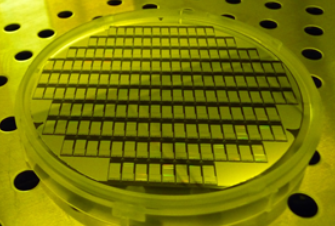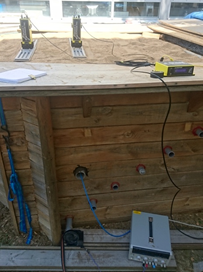UNDERGROUND
Acronym : UNDERGROUND
Project leader : Jean-Michel Friedt
Partnership : TOTAL and FEMTO-ST
Abstract :
 A complete wafer of microfabricated acoustic sensors
A complete wafer of microfabricated acoustic sensorsThe project aims at meeting environmental challenges related to land restoration following its use by oil industry infrastructures by providing the means for long term monitoring of organic pollutants in the subsurface. Our answer to address this problem is to develop a measurement system in which passive (no local energy source next to the sensing element) wireless sensors are deployed and probed from the surface. The sensors, a cooperative target whose signature is acquired from the surface using a classical geophysical tool – a Ground Penetrating RADAR (GPR) –, is designed around the conversion of the incoming electromagnetic field to an acoustic wave. Such a Surface Acoustic Wave (SAW) transducer, fabricated by patterning electrodes on a piezoelectric substrate, provides the chemical sensitivity by exhibiting a dependence of the acoustic velocity with mass loading. This acoustic velocity is measured as a variation of the echo delay – with a differential measurement between chemically functionalized and non-functionalized acoustic paths for getting rid of the RADAR to sensor distance and acoustic velocity temperature dependence.
The selectivity is provided by the dedicated thin film (i. e. chemical functionalization) designed for sensing a given set of compounds, inspired from well known bulk chemical reaction schemes transferred to cleanroom compatible (photo)resists. While GPR instruments are commercially available and their ability to acquire the echoes delayed by the cooperative target has already been demonstrated, their suitability to recovering the quantity under investigation, here analyte concentration, remains to be addressed.

A sandbox with the ground penetrating RADAR for the wireless detection of H2S
While a custom GPR meeting those requirements, matching the sensor transfer function and high stability timebase, is developed during the project, assessing the suitability of a commercial unit will provide the baseline with which our system will be compared. Most significantly, the stroboscopic timebase stability appears as an issue for the fine phase measurement we are interested in, and drift mitigation strategies are investigated.
Finally, deployment of the sensor in a relevant environment requires a strong packaging yet allowing the sensing area to be in contact with the fluid containing the compound under investigation, in addition to an antenna designed to radiate efficiently towards the surface while being compatible with insertion in the soil by using coring tools. Meeting all these challenges will allow for the deployment of the sensors on relevant sites, following their calibration and assessment of the sub-ppm detection limit in controlled environments.
Funding agency : Agence Nationale de la Recherche
Grant or funding obtained : 750k€
Start and end dates : 2017– 2023
Corresponding publication : DOI: 10.1021/acssensors.0c00013

